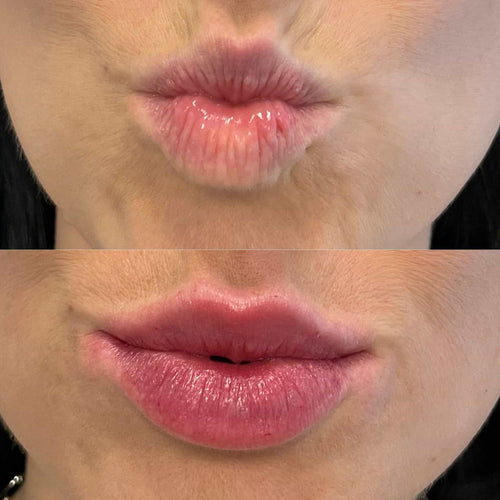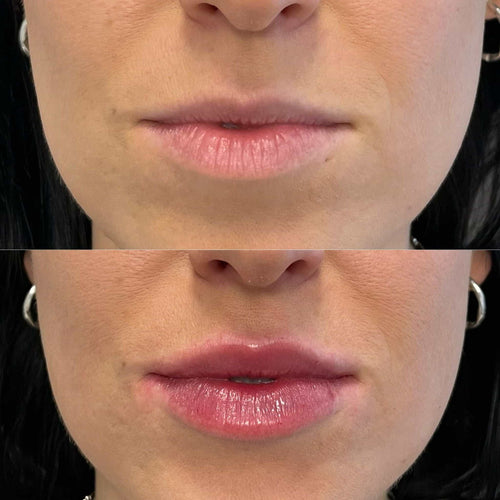Arrange a Consultation for Dermal Fillers with Dr. Laura Geige
## Hyaluronic Acid
Hyaluronic acid (HA) is a naturally occurring substance found throughout the body, particularly in the skin, eyes, joints, and connective tissues. It acts as a humectant, meaning it attracts and retains water molecules, giving it excellent moisturizing properties.
In cosmetic procedures, hyaluronic acid is often used as a dermal filler to add volume and plumpness to areas such as lips, cheeks, and under-eye hollows. Its gel-like consistency allows for smooth injection and gradual integration with the existing tissue.
Since HA fillers are biocompatible and biodegradable, they eventually break down naturally within the body over time. However, when a patient desires to dissolve or remove these fillers, hyaluronidase is used.
Hyaluronidase is an enzyme that specifically breaks down hyaluronic acid molecules. It is injected into the area where the filler has been placed.
When hyaluronidase encounters HA in the dermal filler, it catalyzes the hydrolysis of its glycosidic bonds, effectively breaking down the HA structure. This process causes the filler to dissolve and be absorbed by the body over a period of days to weeks.
The use of hyaluronidase is generally safe and well-tolerated, but some potential side effects can include redness, swelling, bruising, and tenderness at the injection site.
### What It Is
Lip filler dissolution typically involves using a medication called hyaluronidase.
Hyaluronidase is an enzyme that breaks down hyaluronic acid, the substance most commonly used in dermal fillers, including those injected into lips.
Here’s how it works:
- Injection: Hyaluronidase is injected directly into the area where the lip filler has been placed.
- Breakdown of Hyaluronic Acid: The enzyme then begins to break down the hyaluronic acid molecules, effectively dissolving the filler.
- Absorption: The broken-down hyaluronic acid is absorbed by the body naturally.
It’s important to note that:
*
Hyaluronidase can be effective in reversing both temporary and semi-permanent lip filler.
*
The results are usually visible within a few days, with complete dissolution taking up to a week or longer.
*
Dissolving lip filler is a medical procedure that should only be performed by a qualified and experienced healthcare professional.

It’s crucial to discuss your goals and expectations with your provider before undergoing any treatment.
Hyaluronic acid is naturally occurring substance found in the body’s connective tissues. It helps to retain moisture, providing volume and plumpness to skin.
Hyaluronic acid (HA) is a naturally occurring glycosaminoglycan, a type of complex sugar molecule found abundantly throughout the body’s connective tissues. It acts like a sponge, attracting and holding water molecules, which gives it the remarkable ability to retain moisture.
This property makes hyaluronic acid crucial for maintaining skin hydration, volume, and elasticity. It plumps up the skin, reducing the appearance of fine lines and wrinkles, and contributes to a youthful, dewy complexion.
In cosmetic procedures, HA is often used as a dermal filler. Its ability to attract water allows it to effectively add volume and fullness to areas such as lips, cheeks, and under-eye hollows.
### Why It’s Used to Dissolve Lip Filler
Hyaluronic acid (HA) fillers are commonly used in cosmetic procedures like lip augmentation because they provide a natural-looking and reversible enhancement.
This reversibility is due to HA’s unique characteristic: it can be easily broken down by an enzyme called hyaluronidase.
Hyaluronidase, naturally occurring in the body, speeds up the process of hyaluronic acid degradation.
When injected into the area where HA filler has been placed, hyaluronidase works to break the filler molecules apart, effectively dissolving them.
This makes it possible to safely and effectively remove unwanted lip filler or correct any asymmetry or overcorrection.
The dissolving process is typically gradual and painless.
Patients may experience some mild swelling or bruising at the injection site, which usually subsides within a few days.
It’s important to note that hyaluronidase should only be administered by a qualified and experienced medical professional.
The gellike consistency of hyaluronic acid fillers allows for a safe and reversible procedure. When hyaluronidase is injected, it breaks down the hyaluronic acid molecules in the filler, gradually dissolving them over time.
Hyaluronic acid (HA) fillers are commonly used in cosmetic procedures to add volume and plumpness to areas like lips, cheeks, and under the eyes.
These fillers are chosen because they are naturally occurring substances found in the body’s connective tissues. HA helps to retain moisture, giving skin its elasticity and suppleness.
The gel-like consistency of HA fillers allows for precise injection and a smooth, natural look.
Importantly, their use is considered safe and reversible.

If you experience any dissatisfaction with the results or wish to alter your appearance, there’s an easy solution: hyaluronidase.
Hyaluronidase is an enzyme that specifically breaks down hyaluronic acid molecules.
When injected into the area where HA filler was placed, it systematically dissolves the filler material over time.
This breakdown process is gradual, allowing for controlled and predictable results.
Hyaluronidase treatments are typically safe and well-tolerated, although some mild side effects like bruising or swelling may occur.
The availability of hyaluronidase makes HA fillers a popular choice for those seeking temporary cosmetic enhancement with the option to easily reverse the treatment if desired.
## Hyaluronidase
Hyaluronidase is an enzyme that breaks down hyaluronic acid.
Hyaluronic acid is a naturally occurring substance in our bodies, found in the skin, connective tissues, and eyes. It acts as a lubricant, shock absorber, and moisturizer.
Dermal fillers, which are often used to enhance facial features or smooth wrinkles, are typically made from hyaluronic acid.
When someone wants to dissolve lip filler, hyaluronidase is injected into the area to break down the hyaluronic acid filler.
The breakdown process is enzymatic and reversible. Hyaluronidase effectively cleaves the hyaluronic acid molecules into smaller fragments.
These smaller fragments are then naturally absorbed by the body.
Hyaluronidase injection is a relatively safe procedure when performed by a qualified medical professional.
Here are some key points about hyaluronidase in lip filler dissolution:
* **Specificity:** Hyaluronidase specifically targets hyaluronic acid and does not affect other substances in the body.
* **Reversibility:** The effects of hyaluronidase are temporary because it breaks down, rather than removes, the hyaluronic acid filler. As the body naturally absorbs the smaller fragments, the area gradually returns to its pre-filled state.
Hyaluronidase is often used in emergency situations to address allergic reactions or complications following hyaluronic acid filler injections.
However, it is essential to note that hyaluronidase does not work on all types of dermal fillers. Some fillers are made from other substances, such as polylactic acid (PLA) or collagen, and hyaluronidase would be ineffective in dissolving them.
Therefore, it’s crucial to consult with a qualified medical professional to determine the appropriate treatment for filler dissolution.
How It Works
Hyaluronidase is an enzyme that specifically targets hyaluronic acid.
Hyaluronidase is a naturally occurring enzyme found in various tissues throughout the body, including the skin.
It plays a crucial role in breaking down hyaluronic acid (HA), a complex sugar molecule that provides structure and hydration to connective tissues.
In cosmetic procedures, hyaluronidase is used specifically to dissolve HA-based dermal fillers.
Dermal fillers are injected into the skin to add volume, smooth wrinkles, or enhance facial contours. These fillers typically consist of hyaluronic acid gel, which acts as a scaffold for supporting and plumping up the skin.
When hyaluronidase is injected near a HA filler, it binds to the hyaluronic acid molecules within the filler and begins to break them down into smaller fragments.
This process of hydrolysis gradually dissolves the filler material, reducing its volume and smoothing out any lumps or irregularities.
The effects of hyaluronidase are localized to the area where it is injected.
Once the HA filler has been dissolved, the body’s natural processes can absorb the fragmented hyaluronic acid.
### Safety and Side Effects
Dissolving lip filler typically involves using an enzyme called hyaluronidase.
Hyaluronidase works by breaking down hyaluronic acid, which is the primary component of most dermal fillers, including those used for lips.
When injected into the treated area, hyaluronidase targets and degrades the hyaluronic acid molecules, effectively dissolving the filler over a period of time.
The procedure is generally considered safe when performed by a qualified and experienced medical professional.
However, as with any medical treatment, there are potential risks and side effects associated with dissolving lip filler.
These can include:
Book a Dermal Filler Appointment at It’s Me and You Clinic with Dr. Laura Geige
-
Bruising or swelling at the injection site
-
Redness or tenderness
-
Infection (although rare)
-
Asymmetry or uneven results
-
Allergic reaction to hyaluronidase, although this is uncommon
To minimize the risk of complications, it’s important to choose a reputable injector who has experience dissolving fillers and follows strict safety protocols.
Discuss your medical history, any allergies you have, and your expectations with the injector beforehand.
Schedule a Consultation for Dermal Fillers with Dr. Laura Geige
Administered correctly by a qualified professional, hyaluronidase carries few significant side effects. Most common are temporary redness, swelling, or bruising at the injection site.
Hyaluronidase is an enzyme that naturally occurs in the body and plays a role in breaking down hyaluronic acid. This is the same substance used in many lip filler injections.
When administered correctly by a qualified professional, hyaluronidase acts as a “reverse” agent for hyaluronic acid fillers. It effectively dissolves the filler particles, gradually reducing their volume and restoring the natural contours of the lips.
Because hyaluronidase is naturally occurring in our bodies, it’s generally well-tolerated.
Side effects are usually mild and temporary, typically confined to the area where the injections were administered.
Most common side effects include:
-
Redness: This is a normal inflammatory response to any injection. It usually fades within a few hours or days.
-
Swelling: Similar to redness, swelling is expected but generally subsides quickly.
-
Bruising: Tiny blood vessels may be damaged during the injection process, leading to minor bruising. This typically resolves within a week or so.
It’s important to note that these side effects are usually mild and manageable. However, if you experience any unusual symptoms or concerns after receiving hyaluronidase treatment, consult your injector or healthcare professional immediately.
Otherwheres Magazine Cycle for Azaylia Canniant Plinr Decléor Direct
